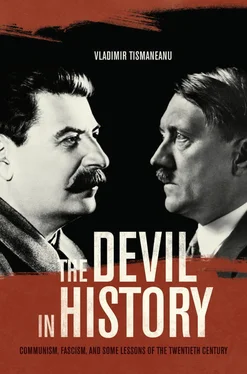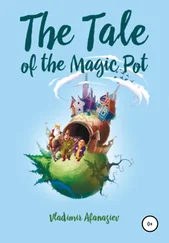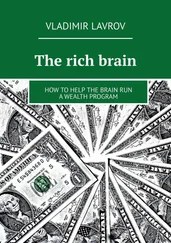At the same, the party apparatus never played as powerful a role in Nazi Germany as it did in Stalin’s Russia. In fact, Hitler envied Stalin for having been able to place political officers as ideological watchdogs in the army. Historian Ian Kershaw stresses the fact that even when Martin Bormann took over the party leadership in May 1941, thus bringing “the Nazi Party’s interference and scope for intervention in shaping the direction of policy to a new plane,” the internal contradictions and incoherencies of the National Socialist state remained. 35The Nazi Party (NSDAP) never enjoyed the same charismatic status that the Bolshevik vanguard had acquired. In Hitler’s Germany, loyalty belonged to the Führer as the embodiment of the pristine völkisch community. In Stalin’s Russia, the zealots’ allegiances went to the leader to the extent that they saw him as the incarnation of the party’s wisdom.
When he maintained that the cadres decided everything, Stalin really meant it (with him being the ultimate arbiter of promotions and emotions): “A great deal is said about great leaders. But a cause is never won unless the right conditions exist. And the main thing here is the middle cadres…. They are the ones who choose the leader, explain our positions to the masses, and ensure the success of our cause. They don’t try to climb above their station; you don’t even notice them…. Generals can do nothing without an officer corps.” 36
STALIN, HITLER, AND THE APOTHEOSIS OF TERROR
This indeed is a crucial distinction between Stalin and Hitler. Stalin for most of his rule was successful in finding a synthesis between government and ideology, system-building and ideological expansion. His politics of mobilization, however destructive for the Soviet population, did not obliterate the formal mechanisms of state administration. In Germany by contrast, “Hitler was at one and the same time the absolutely indispensable fulcrum of the entire regime, and yet largely detached from any formal machinery of government.” In this context, the institutions of the Nazi state were transformed into “a panoply of overlapping and competing agencies dependent in differing ways upon the ‘will of the Führer.’” 37In the Soviet Union, Stalin successfully managed to etatize the Leninist utopia—what he called “building socialism in one country.” In Germany, governmental disorder became an inescapable facet of the Nazi polity’s cumulative radicalization. This difference between Stalinism and Nazism lies at the basis of Timothy Snyder’s explanation for Stalin’s inability to instrumentalize a new wave of terror against the Jews in the aftermath of the Second World War. The Soviet leader “found himself threatening security chiefs, rather than instructing them…. They [his subordinates] were constantly hindered by a certain attention to bureaucratic property and even, in some measure, to law.” 38According to political scientist Kenneth Jowitt, Leninism, understood as an organizational mode, was constructed upon the core idea of the “impersonally charismatic” party. Stalin, despite his development of the original model and his absolutism, simply could not bring another Great Terror upon a party that had just vindicated its historical messianism in what came to be called the Great Patriotic War for the Defense of the Motherland. Either the party, with its extraordinary organizational skills, was the main hero of the victory over the Nazi aggressors or it was a shelter of vicious enemies that needed to be exposed. Initiating a new onslaught against the Communist elite would have subverted the Great Patriotic War myth.
True, Lenin was not the embodiment of the party bureaucracy. In this respect, Robert Gellately draws fine and necessary distinctions: during the Great Terror, Bolshevism created universal fear among all strata of the population. The Leninist project, as developed by Stalin, meant a continuous aggression of the party-state against all social groups, including the much-acclaimed proletariat and its party. Mass mobilization and fear were not mutually exclusive, and millions of ordinary citizens became involved in the bloody dramaturgy of hysteria and persecution. 39David Priestland correctly emphasizes that the specific dynamics of the Bolshevik regime under Stalin were the result of an ideological context similar to that of Lenin’s years at the helm of the Russian Communist Party. Stalin continually agonized over finding the right combination of “proletarian consciousness as a vital force in history and politics,” science-driven progress, and the vision of a society or world structured according to class origin. 40
Communism and Fascism shared a similar obsession with continually moving forward to avoid the damning specter of stagnation. Mao once stated that “our revolutions are like battles. After a victory, we must at once put forward a new task. In this way, cadres and the masses will forever be filled with revolutionary fervor instead of conceit.” 41Eugen Weber proposed a similar diagnosis for Fascism: “The fascist must move forward all the time; but just because precise objectives are lacking he can never stop, and every goal attained is but a stage on the continuous treadmill of the future he claims to construct, of the national destiny he claims to fulfill.” 42On the path to permanent transformation, both Communism and Fascism engineered (or, rather, aimed at) the extinction of the individual by inventing equally binding criteria of faith, loyalty, and status crystallized into a master political myth. And, indeed, this defines the religiousness of a collective existence—“Quand on met toutes les ressources de I’esprit, toutes les soumissions de la volonté, toutes les ardeurs du fanatisme au service d’une cause ou d’un être qui devient le but et le guide des pensées et des actions [When one subjects all resources of the spirit, all the will’s submissions, all the ardors of fanaticism to a cause or a being that becomes the goal and the guide of all thoughts and actions].” 43
Both Stalinism and Nazism emphasized the need for social integration and communal belonging through the exclusion of specific others. Historian Richard Overy describes the two regimes as “all holistic dictatorships.” They relied on “creating complicity, just as they operate[d] by isolating and destroying a chosen minority, whose terrorized status confirm[ed] the rational desire of the rest to be included and protected.” 44Their legitimacy was based upon a synthesis between coercion and consent. In this sense, totalitarianism was embodied by the masses, who “gave life and direction to it.” 45Both the Soviet Union and Germany went through massive social and political tumults in the aftermath of the First World War. By the time Stalin and Hitler came into power there was indeed “a wide popular consensus for a politics without conflict and a society without divisions.” 46In reestablishing and re-creating social order, these states proved to be both repressive and paternalistic. Society was structured according to categories such as class, race, nationality, and gender, each with specific consequences on the inclusion-exclusion axis. Both the Soviet Union (and later, the East European countries) and Germany were realigned demographically, geographically, and biologically according to imagined projects of the perfect citizenry. The developmental and exterminist metaphors adopted and implemented by the two dictators and their power apparatuses became the life framework for the subject population, the groundwork for the reinvention of both individual and collective identities. The macrostrategies of the state suffered a process of translation and adaptation into microstrategies of the individual. Socialization turned into political practice, into an effort to align “what one does with what s/he thinks and says about what s/he does.” 47
Читать дальше












